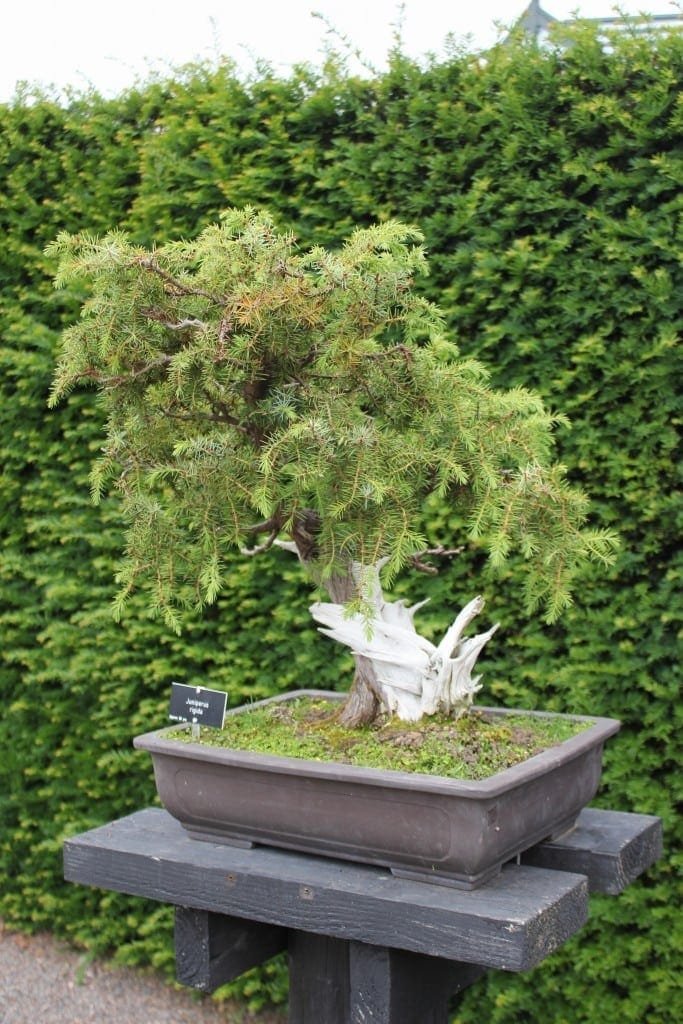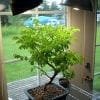Bonsai is the art of growing a miniature tree in a pot, but as an art, bonsai does much more. Everything in the process is meant to bring balance to the tree as an artistic composition, while at the same time maintaining the tree in a natural form.
The bonsai pot is traditionally flat and wide to balance the shape of trunk and branches. Every bonsai style evokes natural shapes and forces that exert themselves upon full-sized trees in the environment. Some forms seem to mimic very upright trees, while others typify the action of wind, water and gravity.
Specimen or Style, Which Comes First?
Not every plant available for bonsai is suitable for every style. Very upright plants go well with broom, upright formal and upright informal styles, but try to use these trees with slanted or cascading styles and rigid trunks may snap.
Instead, vining or bendable plants are better suited to those styles. Since this is true, it may seem like the best advice is to choose the plant based on the desired style, but sometimes artists come by plants first. In that case it pays to be flexible about the final shape of the tree.
Where Plants Come From
A lot of online vendors sell seeds for bonsai and seeds can be a wonderful resource. They allow growers who might not have access to exotic species to grow many interesting bonsai specimens. Seeds take time to germinate and mature, so a seed grown bonsai can be a very long term project.
Some plant species grow well from cuttings. Willow is extremely easy to propagate this way. Grape and fig are almost as easy. They start well in dirt or water. Cuttings can be readily purchased or traded through online forums or gathered from the wild. Air layering is a good way to make cuttings from plants that are more difficult to root.
The process is similar to other methods of rooting, but the wounded branch remains attached to the parent tree while roots are forming in a sterile medium wrapped around the base of the cutting.
Nursery grown or wild trees are a good starting place for bonsai. Most have sturdy trunks that can be trimmed to size for use in bonsai culture. Shrubs are even easier to alter for use as bonsai. Free or cheap trees and shrubs may be available when businesses close or redo their landscaping. Hotels, restaurants and condominiums are excellent sources of unwanted plants.
Choose a healthy plant with unblemished leaves and a pleasing shape for bonsai. Growing a bonsai tree can be challenging enough, so leave any sickly or under-watered stock on the shelf.
Tools and Materials
- One Sturdy Tree or Shrub
- One Bonsai Pot or Hollowed Stone with Drainage Holes
- One Quart of Soil Mixture
- One Miniature Rake
- One Pair of Rose Clippers
Sapling Training and Recovery
Grow the tree out to the desired trunk thickness, if it is not the right size already. If the plant was collected in the wild, pot it in a temporary pot large enough to support the full size of the sapling and allow the roots to recover from any collection trauma. Begin the top pruning and training process during the growth and recovery period.
The Bonsai Pot
The bonsai pot accounts for almost half of the composition. It should be low, but wide enough to support the plant’s roots. Cascading trees have larger pots to allow the top of the tree to hang lower than the top of the roots. The thin, wide pot profile is meant to balance with the tree composition and help the illusion of a full tree in miniature. Choose a color that you find pleasing and a size that will go well with the size and shape of the tree.
Potting Mix
Most prepackaged potting soil is too rich for bonsai trees. Added peat moss prevents the small bonsai pot from draining. Play sand makes a very good soil additive. It increases drainage properties and mixes well with packaged soils, but it also forms a good base for custom mixes.
In the past many bonsai soil mixes included organic materials, but more recent practices include inorganics like volcanic gravel and baked clays. Natural bark pieces are still widely used in bonsai soil because this additive takes time to break down to a point where it causes problems with water retention. Flowering species require more water retention than non-flowering species, so gear soil mixes accordingly. Lack of organic composition in the soil means that slow release fertilizers will be needed.
Root Trimming
When the tree has recovered and grown out enough, remove it from the temporary pot. If the roots had begun to circle in the pot, use a small rake to loosen the soil and comb them out straight. Before repotting, the roots need to be trimmed. The final root mass should fan out like a dust mop to just fill the bonsai pot with a little room left for growth.
Potting
The pot should have at least one hole for drainage. If it has no holes, drill one. Line the bottom of the pot with a small piece of screen, and then place a thin layer of gravel on the bottom of the pot. Followed by a thin layer of soil. Place the tree in the pot and finish covering the roots with soil.
Plan to repot the tree or trim the roots yearly to prevent root binding. If you are repotting into larger pots yearly, plan to trim roots every third year to control leaf size.
Decoration
Moss and natural-colored stone or gravel help simulate grass and stones normally found under trees. Add these sparingly. Mosses will fill in empty spaces over time.
Bonsai is an art form that requires skill and patience. Care and planning provides a support system to help keep these growing artworks alive. Root trimming and pruning keep the specimen plants small and the distinctive, low bonsai pot completes the composition while providing practical support for the feeding roots.


